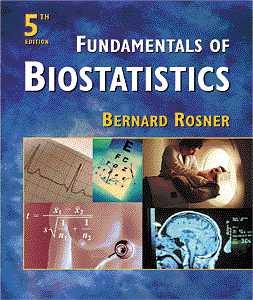
Fundamentals of BIOSTATISTICS
, 5th Edition,
by Bernard Rosner © 2000
Datasets from Fundamentals of Biostatistics

by Math Soft, Inc. ©2000
| Office: | |
| Phone: | 668-2649 |
| Email: | heidi@stat.duke.edu |
| Office Hours: | M,W,F 1-3pm |
The Syllabus I handed out on the first day of class is available in both postscript and pdf format, should you want to download it.
|
|
|
|
|
|
|---|---|---|---|---|
| Gwenden L. Dueker | gwend@duke.edu | |||
| Ana Rappold | ana@stat.duke.edu | 684-4365 | Old Chem 212 |
Reading and interpretation of statistical analyses from life science and medical
literature. Conceptual bases for using data and understanding uncertainty when
making treatment decisions about patients. Includes extensive reading and class
discussion of articles from the medical literature. Topics include: basic concepts
and tools of probability and conditional probability, independence, two-by-two
tables, Simpson's paradox, medical diagnosis, ROC curves, study designs for
medical problems, inference and hypothesis testing for randomized clinical trials's
and basic survival analysis. Emphasizes role of biostatistics, drug testing,
and clinical trials in modern society. No prerequisites.
| TEXT (required) | ||
|
|
by Bernard Rosner © 2000 |
|
| SOFTWARE | ||
|
|
S-Plus 2000
for Windows by Math Soft, Inc. ©2000 |
We will cover material in Chapters 1-14 of the text. This will be a fast paced course and it is necessary that you keep up with the material and assignments in order to receive a passing grade. You should expect to put in 6-8 hours per week as a minimum. Daily topics and homework assignments are posted in the Course Calendar which is available from the course homepage. This will be updated throughout the course as necessary. Other information and resources will be available on the ACPUB Course Info site for the course. Bookmark:
for access to handouts, assignments, online discussion, class email, current grades, and more! (requires ACPUB account to access)
Recitation sections are scheduled to meet in Teer 106. If you wish to attend a different lab section for any reason, you should first check with the lab instructors to ensure that there is space. You will go over assignments and occasionally receive instruction to supplement the lecture in the recitation sections. Time will usually be scheduled for individual help. Quizzes will be given during the recitation section.
We will be using S-Plus for course. S-Plus is a powerful, flexible program and has the advantage over SAS and other programs of being easy to customize and provides excellent graphics. You can also save/edit your programs, which can be useful for research projects. Statistics packages, such as S-Plus and SAS, take some time to get use to, so hang in there! It may take a few weeks before you start to feel comfortable. We have a site license that will allow you to download a copy of S-Plus for free! For those without computers, the PC clusters on campus do have S-Plus on them. (note: there is a PC lab with S-Plus in the basement of Old Chem). You may also use the UNIX version of S-Plus, if you prefer.
There will be approximately 13 weekly assignments and labs throughout during the semester. Assignments and due dates are posted on the web. No late homework will be accepted. PERIOD. You are permitted and encouraged to discuss homework problems with others in the class, but the work turned in must be your own. Conscientious completion of all homework assignments is essential for learning the material and getting a good grade in this course. The lowest 2 quizzes will be dropped in determining your grade. No make up quizzes unless you bring in a Dean's excuse; make up quizzes will be oral.
You will also need a hand calculator that can find roots, logs and exponentials. Bring your calculator to the quizzes and exams!